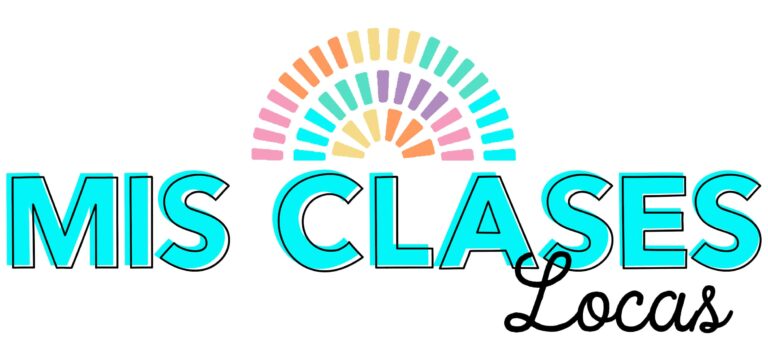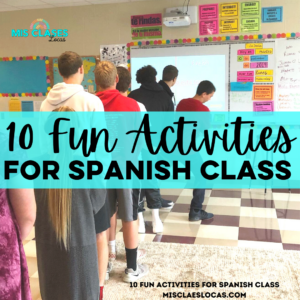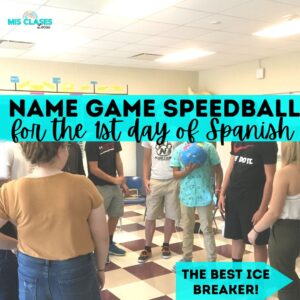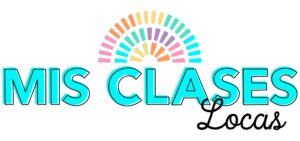Do your students struggle with how to write in Spanish? Do you need writing in Spanish practice for your classes? Practice writing in Spanish with these fun writing activities and games in Spanish.
Author – Allison Wienhold
Published – March 24, 2024
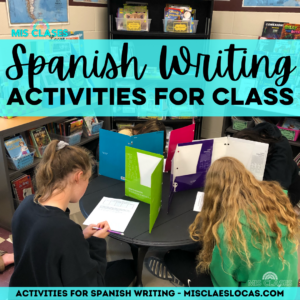
Writing Activities in Spanish Class
- Musical Chair Writing
- Snow Ball Fight Writing
- Spanish Free Write
- Spanish Creative Writing Prompts
- Journaling in Spanish Class
Musical Chair Writing – Musical Chair Retell

If you are looking for writing in Spanish practice, Musical Chair Writing is a fun collaborative twist that can be used to practice writing in Spanish. I first posted about Musical Chair Retell in 2016 in the blog post about teaching the novel Tumba 5 Activities to spice up any novel and again in Activities for Spanish Class Novels. I originally used musical chairs retell for students to retell and review a book.
But, Musical Chair Writing can also be used creatively as a no-prep activity to practice writing in Spanish. Use musical chair writing to collaboratively come up with silly stories, write spooky legends, or write about what happened over the weekend at the school for Weekend Chat.

Materials needed for Musical Chair Writing
- Lined paper for each student
- Each student needs a writing utensil
How to play Musical Chair Writing in Spanish Class
- Have a blank piece of lined paper at each student’s desk or table.
- Students start retelling the story or chapter writing in Spanish.
- Play music. That is the signal for students to stand up and walk/dance around the room like musical chairs. They leave their paper at their original place. When the music stops students sit at a new desk. No one is out and everyone gets to keep writing. 🙂
- Students read what is on the new paper in front of them. Students continue writing in Spanish where the first person left off.
- Repeat with music and writing a few times as long as interest continues.
- At the end, give students back their original papers to read and edit the final product.
- As an extension, have a few students or the teacher share the best versions out loud.
Snow Ball Fight Writing in Spanish Class

I originally posted about a variation of Snow Ball Fight in Spanish class with La Tomatina. In that version, we used red paper to have a tomato fight. Since it was a start of the year ice-breaker, students wrote a fact and others guessed who wrote it. There are many types of writing practice activities in Spanish you can use with versions of a snowball fight. (No real snow needed:)
Materials needed for Snow Ball Fight Writing
- Computer paper for each student (can be recycled scratch white computer paper)
- Writing utensils for each student

How to play Snow Ball Fight Writing in Spanish Class
- Decide what students will write about in Spanish. This could be retelling a story or chapter as a review. Or it can be a creative story to practice certain high-frequency verbs or vocab that you need to practice how to write in Spanish.
- Instruct students to start writing in Spanish on a piece of computer paper. They should write at a normal size so there is room for others to add to the writing.
- Then once given the signal with fun music, students crumple up their paper and have a “snowball fight.” Students get to keep throwing their paper snowballs as long as the music plays.
- When the music stops, students should pick up a piece of paper. They read what is written so far, and continue writing in Spanish where the first person left off.
- Repeat the process of writing, snowball fight, and get a new paper a couple of times.
- At the end, give students back their original papers to read and edit the final product. As an extension, you can have a few students or the teacher share the best versions out loud. You can vote for the best/silliest/scariest writing based on the given task.
Free Write

A free write is exactly what it sounds like, writing Spanish over any topic. A truly free write is just setting a timer for 5-10 minutes and letting students write in the target language. If your students are struggling with how to write in Spanish, practice it often in a low-stress way.
I know that for many students such as my own son, completely open writing can cause stress. It can be helpful to give suggested topics as a way to support all students.
I start this kind of open writing over our special person interviews in week 1 as a part of my High-Frequency Verb Unit to Start Spanish 1. They are free to write about anyone who was interviewed that day and retell as much as they can. These retells can also be done in small groups to get more details collaboratively.
If you have 5-10 minutes left at the end of class, have students get out a piece of paper and write down as much as they can remember from the chapter, story or topic of the day as an exit ticket.
Creative Writing Prompts
For upper-level or Heritage students, try creative writing in Spanish class. Creative writing prompts can inspire students to craft original stories, narratives, or poems entirely in Spanish. From fairy tale retellings to futuristic narratives, there are many options. My biggest suggestion is to have students write on paper in class to see authentic student writing.
These creative writing tasks in Spanish can be done independently or you can encourage collaborative storytelling activities. Students can work together and take turns adding to a collective story. Creative writing empowers students to express themselves authentically in the target language.

Creative Writing Prompts in Spanish Examples
- Create a poem imagining a parallel universe where Spanish is the dominant language worldwide. Reflect on how everyday life, culture, and interactions might be different in this alternate reality.
- Write a letter to your future self reflecting on your journey of learning Spanish. Describe the challenges you’ve overcome, the milestones you’ve achieved, and your aspirations for further language learning and cultural exploration.
- Invent a fantasy celebration inspired by folklore or mythology. Describe the customs, costumes, and creatures involved in this imaginary festival, and explain its significance within the culture.
- Write a detective story set in a Spanish-speaking place. Create intriguing characters, plot twists, and clues in Spanish as you unravel a captivating mystery.
- Write a short story about a humorous misunderstanding that occurs due to language barriers while traveling in a Spanish-speaking country. How do you navigate the situation and what lessons do you learn about communication?
Past Tense Creative Writing
- You wake up one morning and realize you’ve traveled back in time to a historic event in a Spanish-speaking country. Write a journal entry detailing your experience and interactions with people from that time period.
- Write your unique creative twist on a class fairy tale.
Future Tense Creative Writing Prompts
- Imagine you’re planning a trip to a Spanish-speaking country you’ve always dreamed of visiting. Write about your plans discussing your excitement, itinerary, and expectations for the trip.
- Imagine a futuristic society where Spanish is the universal language of communication. Write a science fiction story exploring how technology, culture, and global interactions will evolve in this Spanish-speaking world of tomorrow.

Journaling in Spanish Class
Another writing in Spanish class practice activity for upper-level or Heritage Spanish is journaling. This provides a space for students to express their thoughts, feelings, and experiences in Spanish. This is a great way to prepare for the AAPPL test in Spanish class.
I would make sure that there is not a set grade over the journal if you want true reflections. Instead, if students are comfortable, they could share select journal entries with just the teacher as they walk around.
Journalling in Spanish could be daily reflections, travel diaries, or imaginative storytelling. If students need prompts to get started, you can give them an optional topic.
Journal ideas in Spanish Class
- Describe a favorite holiday tradition.
- Retell your favorite trip.
- Envision a future dream vacation.
- Write about any challenges they face in learning Spanish.
- Write reviews of Spanish-language movies, TV shows, books, or music.
Writing Assessments in Spanish Class

Most of the activities above are formative practice activities for writing. For a writing assessment, I always gave students some kind of heads-up about what they were going to write about. This helped students to be less anxious and to prepare in advance if that suited their learning style.
My number one tip for summative writing assessments that are graded, is to have students write in class on paper. This way you see what the student knows. Depending on the goal of the assessment, maybe students are allowed a notecard with a few key vocabulary words, quotes from the novel, etc. Also, they have access to the posted visual aids and high-frequency verbs to support all students.
Presentational writing was one of the main categories using Standard Based Grading. Typically the end of each major novel unit included an on-paper, in-class writing assessment. This is true for my Literature Circle unit as well.
For efficient grading, embed a mini rubric on the writing assessment handout for quicker feedback. You DO NOT need to correct every error. Give a positive & something to work on overall.
Or for the best feedback, give it orally. Plan a cultural Movie or your Friday TV Show the day after a writing assessment. Pull students one at a time up to your desk for verbal feedback on writing and grade them together.

More Spanish Class Resources
- Speaking Activities for Spanish Class
- Spring Break Chat in Spanish Class
- Spanish Class Routines
- NEW >> Engaging Vocabulary Games in Spanish
- Earth Day in Spanish Class
- Tierra Incógnita – a great show for upper-level Spanish at the end of the year. Get a Freebie below.
